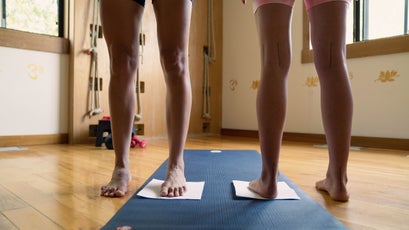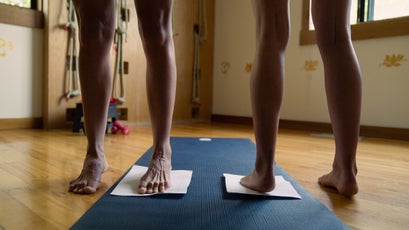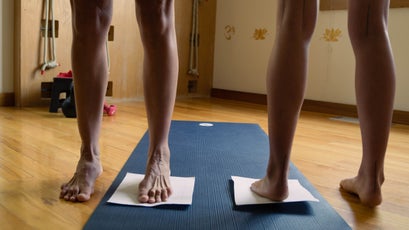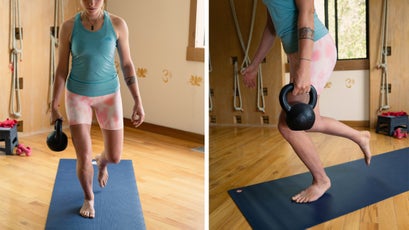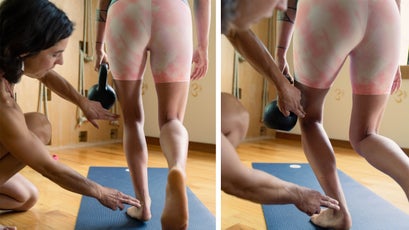How to Fix Fallen Arches
6 min read“],”renderIntial”:correct,”wordCount”:350″>
Our bodies are a little bit like structures: the bodily composition is regularly resisting gravity. Now, picture a skyscraper with a collapsed foundation—it’s not just the ground flooring that are compromised: the entire architecture is at stake. Our feet and ankles are our foundation, and weaknesses here can direct to a host of issues in other places. Fallen arches—also recognised as overpronation—are a popular source of nearby foot and ankle issues and can direct to issues even more upstream, in the knees, hips, and spine.
Correcting Overpronation Is An Inside of Occupation
Overpronation happens when the vertical, curved condition of our all-natural foot arch collapses whilst body weight bearing. The composition of the hips by natural means inclines the system to collapsed arches: the femur bones angle inward, from a large pelvis to a extra narrow foundation of guidance at the feet, exposing our bodies to forces that we have to overcome with postural power. In addition, genetics, muscle and connective tissue weakness, alignment, and gait mechanics can all direct to fallen arches. Symptoms change but consist of clear discomfort, tendinitis, and numbness at the foot and ankle as effectively as extra sneaky complaints up the kinetic chain like knee and hip discomfort.
Typically, overpronation goes hand-in-hand with excessive inside rotation of the femurs, which you can see in the video under. You can look at out your alignment by referencing a few of anatomical landmarks: the vertical tendons of the hamstring muscle tissue driving your knees and the achilles tendons driving your ankles. These should really be oriented straight back again. With excessive inside rotation, you could see them angled somewhat outward.
A person popular answer to overpronation is supportive shoe insoles, which fill the place of the arch and bodily reduce it from collapsing. But that doesn’t handle why the arch is slipping in the first location. The hip muscle tissue, especially the exterior rotators, sit beneath the glute muscle tissue and assist strengthen the neutral situation of the femurs and reduced legs. Activating and strengthening these muscle tissue supports fantastic alignment by means of the reduced system and can assist by natural means elevate and guidance the arches. About time, the human body’s intrinsic ability to self-restore weak muscle, nerves, and connective tissue (which include bone, ligaments, tendons, and fascia) enables us to make long lasting alterations to our composition. The under routines will assist you establish and maintain alignment by means of reliable strengthening and mobility operate.
The Moves
Deep Hip External Rotator Activation: The Fingertip Raise
What it does: Engages the exterior hip rotators to align the anatomical landmarks we discovered previously mentioned and elevate the arches. Helps establish power, elasticity, and resilience in the feet and ankles, knees, and hips.
How to do it: Stand barefoot and picture that you have two flat discs beneath the two of your feet. Engage the deep hip rotators by ‘spinning the discs’ devoid of moving your feet. This will sense like a light twist of your left hip counterclockwise and your appropriate hip clockwise. Your femurs should really spin open up into exterior rotation. Take it easy your quads—the work should really be coming from your hips. Sustain even stress by means of the toes and the balls of your feet.
Your foot situation should really continue to be static apart from for a obvious elevate of the arch, adequate to make it possible for you to tuck your fingertips underneath your arch close to the entrance of your heel. Just go considerably adequate to orient those people tendon landmarks in their great position—otherwise, you can overcorrect into supination, putting excessive body weight on the outdoors of the foot and lifting off of the big toes. You could want the assist of a mirror or a buddy at first.
Quantity: Do 3 to 5 repetitions of activating and soothing. Perform this alignment various moments for each working day, or any time you find oneself standing.
The subsequent moves are portion of the Ground Power collection from Samsara Expertise, the place I operate as a mentor. They will assist your system maintain the previously mentioned structural alignments, and fortify your foot and ankle advanced all the way up to your hips, making a good foundation for motion. Ditch your footwear for these routines to get acquainted with muscle tissue and connections in your feet and legs that you could have never ever felt just before.
Foot Activation
What it does: Repairs the neuromuscular circuits from feet to brain, by activating dormant muscle tissue of the foot and ankle.
How to do it: Stand barefoot with a corrected arch situation. Then, activate the muscle tissue of the two feet by gripping the ground with your toes. It should really sense like a fast snap that elevates your heels about a half-inch and delivers you into an active forefoot stance. Hold your knees straight and smooth, and stay clear of accomplishing a calf raise—this should really all originate with the feet. The gripping motion should really interact the achilles tendons, the calf muscle tissue, the hamstrings, and the glutes. If you’re possessing a tough time accomplishing this move, consider putting a flat sheet of paper beneath your feet and attempting to scrunch it.
Quantity: Perform one particular to 3 sets of 5 to fifteen repetitions. Perform this move often during the 7 days.
Solitary Leg Forefoot Isometric Hold
What it does: Rebuilds the connective tissues of the foot and ankle, strengthens muscle tissue from feet to trunk.
How to do it: Stand on one particular leg, shift your body weight into your forefoot, curl your toes to grip the ground, and then elevate your heel. Hold for thirty to 40 seconds. Use your free of charge fingertips in opposition to a wall for stability if essential. You should really sense the operate in your feet, achilles tendons, calf muscle tissue, and thighs. Your priority here is to retain your arch and your hips steady. Start off with bodyweight, and insert load in the sort of a dumbbell or kettlebell if it feels as well simple. If you opt to use body weight, maintain it in the very same hand as the standing leg. End if you have any discomfort.
Quantity: Perform one particular to 3 thirty- to 40-2nd retains, resting for two minutes in between. Repeat two to four times a 7 days.
Double-Leg Hop in Ground Power Foot Place
What it does: Encourages bone well being, elasticity, and acceptable foot and ankle stiffness.
How to do it: Assume your active forefoot situation with corrected arches. Stiffen your ankle joint, keeping it agency, close to a appropriate angle, and get started hopping with minimal amplitude. In this move you are attempting to educate your feet and legs to endure fast dynamic forces in the active forefoot situation so that you can far better execute quick actions like managing and bounding devoid of overpronation. You also could get started to sense the springiness of your plantar fascia and achilles tendons that enables us to hop, leap, and run with elasticity. Change velocity, peak, and amplitude more than time, as tolerated. End if you have any discomfort or fatigue.
Quantity: Hop for ten to 30 seconds, then relaxation for a minute. Repeat one particular to 3 moments. Do this between two and 5 moments for each 7 days.
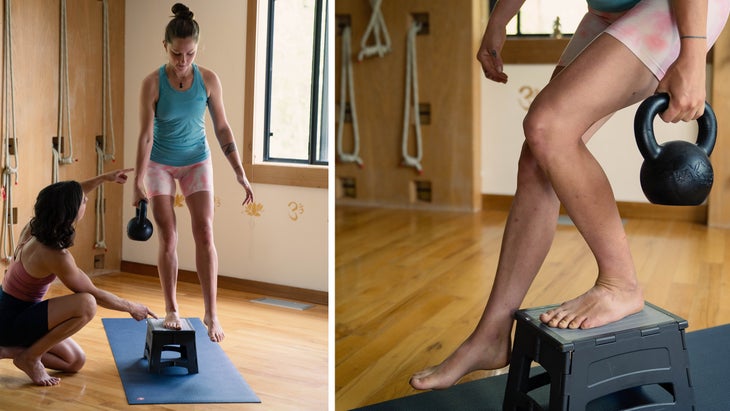
Solitary-Leg Squat on Box or Stage
What it does: Builds power and electric power by improving the integrity of your arches and alignment, and issues your one-leg squat manage and depth.
How to do it: You are going to want a stage and a kettlebell or free of charge body weight for this move. Stand with one particular foot on the stage, knee bent, and the other foot dangling in mid-air in entrance of you. Your standing foot should really be flat, with corrected arch situation. Hold the body weight plumb beneath your shoulder and following to your hip on your standing-leg aspect. Hold your shoulders secure and your trunk upright. As you squat, only go as minimal as you can whilst retaining alignment by means of the hip, knee, and arch. Then, remain minimal and pulse deeper with every repetition. Use your free of charge fingertips in opposition to a wall for stability if essential. Pick out a body weight that enables you to execute six to 8 repetitions devoid of sacrificing your sort. Great sort is the priority, and you should really sense this in the deep hip rotators, glutes, and hamstrings fewer than in your quads. End if you have any discomfort.
Quantity: Two to 5 sets of six to 8 repetitions, with two minutes of relaxation in between.

